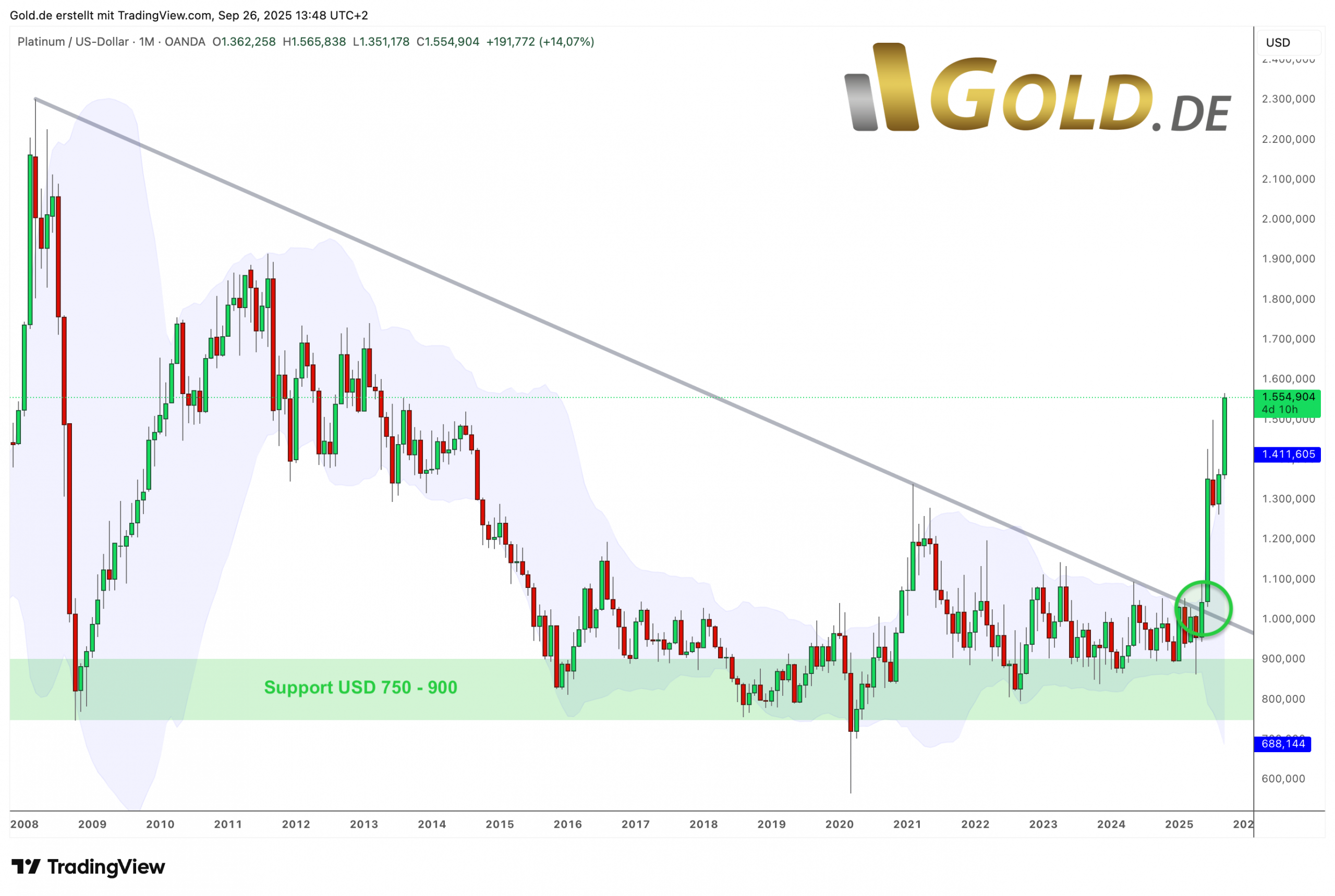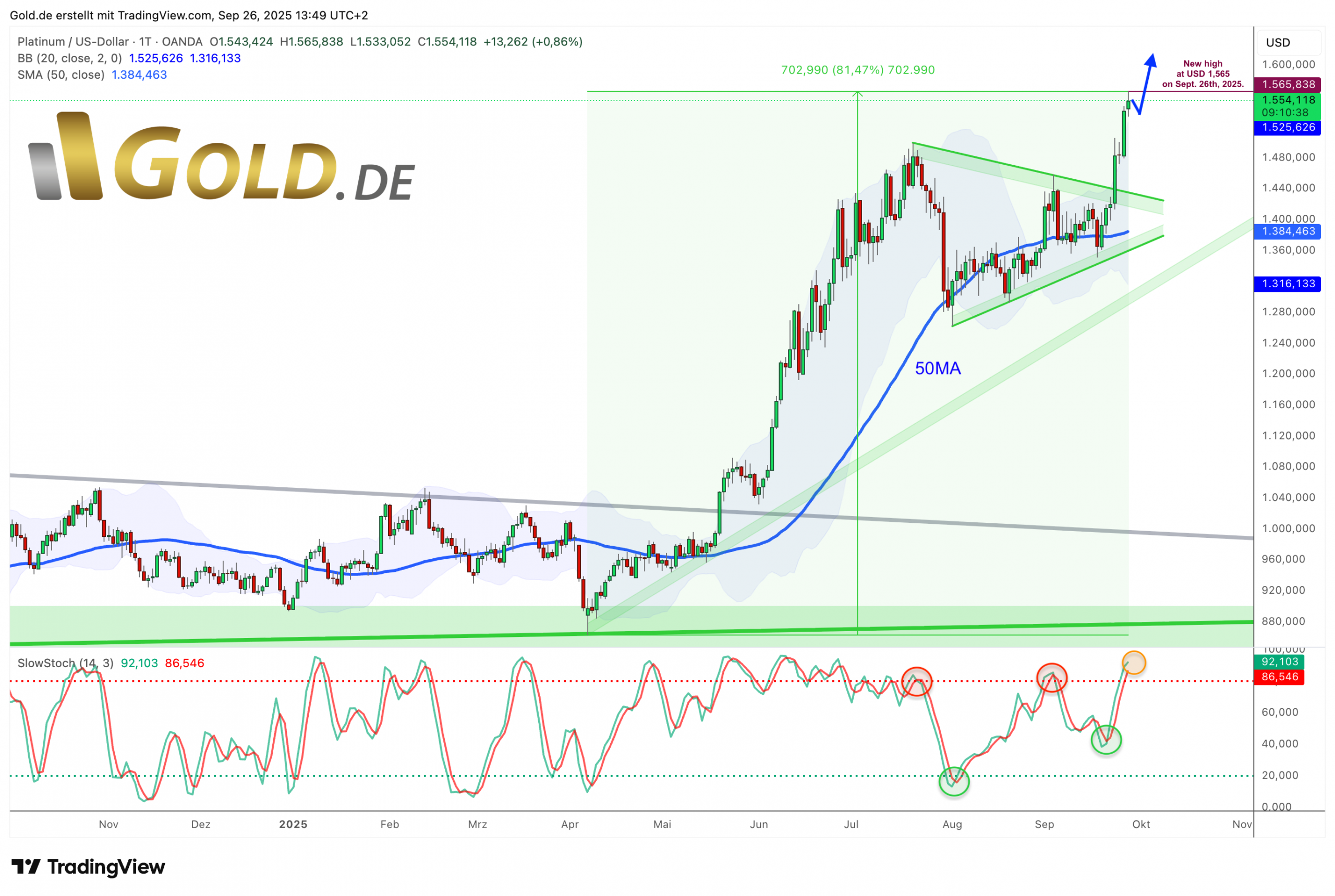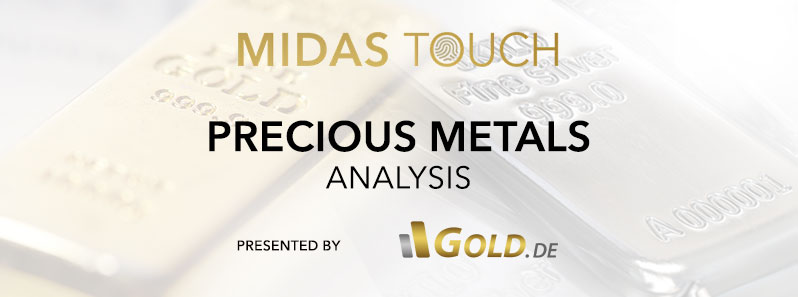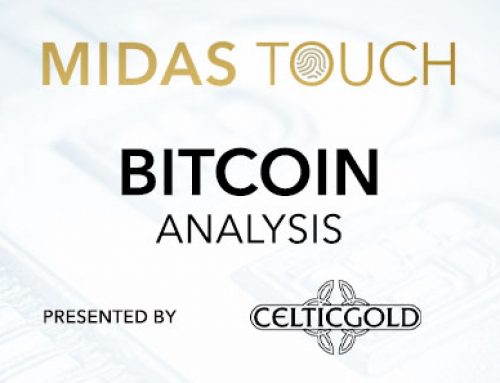Platinum – Awakened from its Sleeping Beauty Slumber
Since the central bankers’ meeting in Jackson Hole on August 21st, the precious metals markets have exhibited impressive upward momentum. After a four-month consolidation, gold surged from USD 3,311 to a new all-time high of USD 3,791 per ounce within weeks. Silver also reached its highest level in 14.5 years at USD 45.63, while the mining sector performed strongly, with the GDX Gold Miners ETF surpassing its 2012 highs and continuing upward.
However, the undisputed leader in the past two quarters has been platinum. Since April 1st, its price has soared by an impressive 81.5%, signaling a remarkable comeback. The breakout above a nearly 17-year downtrend in June triggered significant price gains. Despite a brief correction in late July, platinum quickly recovered and hit a new 12.5-year high in the current trading week. This marks the definitive end to platinum’s long shadow existence, reestablishing it as a robust investment vehicle in the precious metals sector.
Historically utilized by ancient cultures such as the Egyptians and pre-Columbian South Americans, platinum was long undervalued in Europe as “platina,” or “little silver,” due to its difficulty to melt and process. Spanish conquerors in the 17th century found large quantities of platinum during gold panning in South America but discarded it, mistaking it for inferior or immature gold. Political and economic uncertainties around its scarce and unpredictable availability also played a role.
Physical Properties and Geological Occurrence of Platinum
Platinum stands out for its extraordinary physical and chemical properties. It is dense, ductile, malleable, extremely durable, and highly resistant to chemical reactions and aggressive acids. It has a high melting point and excellent catalytic capabilities, making it indispensable to industry. Its silvery-white luster ranks it among the most sought-after precious metals and it is roughly 30 times rarer than gold.
In the earth’s crust, platinum occurs only in very low concentrations. It is often found with nickel and copper ores or as placer deposits, where it has been naturally eroded from source rocks and concentrated in river sediment. About 90% of annual production comes from a few key regions worldwide: Russia’s Ural Mountains, Colombia, Canada’s Sudbury Basin, and especially South Africa, which holds the largest reserves and produces 70 to 80% of global output. Worldwide production ranges from only about 170 to 200 tonnes annually, underscoring its scarcity and value.
Industrial Importance and Demand Drivers
Platinum’s broad industrial uses make it a highly sought-after raw material. It is essential in automotive catalytic converters and is used in laboratory equipment, electrodes, measuring instruments, the glass industry, and high-end dental materials. The jewelry industry also benefits, especially when gold prices reach record highs, prompting consumers—particularly in China—to increasingly choose platinum as an elegant yet more affordable alternative to gold. Unlike gold and silver, which for centuries have been established as monetary metals, platinum is almost exclusively industrially used. Investment demand accounts for only about eight percent of total consumption.
Supply Constraints and Rising Demand Fuel Platinum Prices in 2025
The price increases this year cannot be explained solely by gold’s strength but also reflect structural supply deficits and adverse weather and logistical issues in South Africa, the primary producing country. Despite some recoveries, production remains near five-year lows. Recycling supplements but does not offset mined platinum supply. New projects like the Platreef mine in South Africa may provide additional mid-term supply but are still in development.
On the demand side, stable and even growing consumption from China and the jewelry sector supports prices. A weak U.S. dollar combined with increasing investment interest and ETF inflows adds further upward pressure. Geopolitical tensions such as sanctions on Russia, trade barriers, and uncertainties also boost demand for platinum as a safe haven. Overall, limited availability makes platinum a metal of high geopolitical and economic significance.
Chart Analysis – Platinum in US Dollars – Awakened from its Sleeping Beauty Slumber

Platinum in US-Dollar, monthly chart as of September 26th, 2025. Source: Midas Touch Consulting
The platinum price reached its all-time high in March 2008 at $2,308.80 per ounce, driven mainly by U.S. and European government debt growth, weakening of the U.S. dollar against other currencies, global supply shortages, and rising automotive demand amid South African power supply issues.
During the 2007-2008 financial crisis, platinum fell sharply by about 67% from its peak to $762 by October 2008 due to the liquidity crunch, which severely hit all asset classes and industrial metals demand.
Following the crisis and fueled by the gold bull market, platinum recovered to $1,915 by fall 2011 but did not make new all-time highs like gold. It then fell back into a multi-year correction phase, trading sideways between $750 and $900, overshadowed for nearly a decade. The Covid crash in February 2020 further pushed prices as low as $565.
Breakout and Bull Market Resumption

Platinum in US-Dollar, daily chart as of September 26th, 2025. Source: Midas Touch Consulting
Only in May 2025 did platinum break out above the 17-year downtrend, fundamentally shifting market structure and kicking off a steep, sustainable bull market phase still ongoing today. Early this week, the two-month consolidation triangle was clearly broken to the upside, setting a new target minimum of $1,600. Platinum has about 48% to go to reach its all-time high. Given the overall bullish precious metals sector, prices above $2,000 seem achievable next year.
While the market may be somewhat overheated short term, the bigger picture shows an excellent risk-reward balance for platinum. Any pullbacks should be seen as buying opportunities to capitalize on the newly launched bull phase.
Conclusion: Platinum – Awakened from its Sleeping Beauty Slumber
Platinum has awakened from its 17-year slumber as of May this year and is aggressively closing the gap with gold. Long-term precious metals investors recall that platinum once traded at twice the price of gold. Today, the platinum/gold-ratio is only 0.415, indicating considerable upside potential.
This strong rally over the past six months is not only driven by the impressive gold and silver bull runs but primarily by fundamental market changes. Structural supply deficits caused by South African mining problems, exacerbated by sanctions on Russia, plus stable and growing demand – particularly from China and the jewelry industry- form the base for the sustained price rally. Geopolitical uncertainties, a weak U.S. dollar, and rising investment demand enhance this momentum further.
An Undervalued Powerhouse with Strong Industrial Demand and Bullish Technical Breakout
Historically underestimated and overshadowed by gold and silver, platinum’s exceptional physical properties and indispensable industrial role, especially in automotive, give it high geopolitical and economic relevance. Limited availability alongside increasing investment demand makes platinum a highly compelling and undervalued asset within the precious metals universe.
Technically, the breakout above the long-term downtrend represents a turning point packed with opportunities. Although short-term pullbacks are possible, the risk-reward profile for platinum is very favorable. Investors should view any corrections as buys to benefit from the newly begun bull market and include platinum as a valuable component in their portfolios.
Analysis initially published on September 26th, 2024, by www.gold.de. Translated into English and partially updated on September 28th, 2024.
Feel free to join us in our free Telegram channel for daily real time data and a great community. If you like to get regular updates on our gold model, precious metals, commodities, bitcoin and cryptocurrencies, you can also subscribe to our free newsletter.
Disclosure: This article and the content are for informational purposes only and do not contain investment advice or recommendations. Every investment and trading move involves risk, and readers should conduct their own research when making a decision. The views, thoughts, and opinions expressed here are the author’s alone. They do not necessarily reflect or represent the views and opinions of Midas Touch Consulting.










